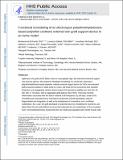| dc.contributor.author | El‐Kurdi, Mohammed | |
| dc.contributor.author | Soletti, Lorenzo | |
| dc.contributor.author | McGrath, Jonathan | |
| dc.contributor.author | Linhares, Stephen | |
| dc.contributor.author | Rousselle, Serge | |
| dc.contributor.author | Greisler, Howard | |
| dc.contributor.author | Edelman, Elazer R | |
| dc.contributor.author | Schoen, Frederick J | |
| dc.date.accessioned | 2022-08-02T15:43:45Z | |
| dc.date.available | 2021-09-20T18:22:09Z | |
| dc.date.available | 2022-08-02T15:43:45Z | |
| dc.date.issued | 2019 | |
| dc.identifier.uri | https://hdl.handle.net/1721.1/132386.2 | |
| dc.description.abstract | © 2019 Wiley Periodicals, Inc. Saphenous vein graft (SVG) failure rates are unacceptably high, and external mechanical support may improve patency. We studied the histologic remodeling of a conformal, electrospun, polydimethylsiloxane-based polyether urethane external support device for SVGs and evaluated graft structural evolution in adult sheep to 2 years. All sheep (N = 19) survived to their intended timepoints, and angiography showed device-treated SVG geometric stability over time (30, 90, 180, 365, or 730 days), with an aggregated graft patency rate of 92%. There was minimal inflammation associated with the device material at all timepoints. By 180 days, treated SVG remodeling was characterized by minimal/nonprogressive intimal hyperplasia; polymer fragmentation and integration; as well as the development of a neointima, and a confluent endothelium. By 1-year, the graft developed a media-like layer by remodeling the neointima, and elastic fibers formed well-defined structures that subtended the neo-medial layer of the remodeled SVG. Immunohistochemistry showed that this neo-media was populated with smooth muscle cells, and the intima was lined with endothelial cells. These data suggest that treated SVGs were structurally remodeled by 180 days, and developed arterial-like features by 1 year, which continued to mature to 2 years. Device-treated SVGs remodeled into arterial-like conduits with stable long-term performance as arterial grafts in adult sheep. | en_US |
| dc.language.iso | en | |
| dc.publisher | Wiley | en_US |
| dc.relation.isversionof | 10.1002/JBM.A.36724 | en_US |
| dc.rights | Creative Commons Attribution-Noncommercial-Share Alike | en_US |
| dc.rights.uri | http://creativecommons.org/licenses/by-nc-sa/4.0/ | en_US |
| dc.source | PMC | en_US |
| dc.title | Functional remodeling of an electrospun polydimethylsiloxane‐based polyether urethane external vein graft support device in an ovine model | en_US |
| dc.type | Article | en_US |
| dc.contributor.department | Massachusetts Institute of Technology. Institute for Medical Engineering & Science | en_US |
| dc.relation.journal | Journal of Biomedical Materials Research - Part A | en_US |
| dc.eprint.version | Author's final manuscript | en_US |
| dc.type.uri | http://purl.org/eprint/type/JournalArticle | en_US |
| eprint.status | http://purl.org/eprint/status/PeerReviewed | en_US |
| dc.date.updated | 2020-10-19T14:11:07Z | |
| dspace.orderedauthors | El‐Kurdi, M; Soletti, L; McGrath, J; Linhares, S; Rousselle, S; Greisler, H; Edelman, E; Schoen, FJ | en_US |
| dspace.date.submission | 2020-10-19T14:11:13Z | |
| mit.journal.volume | 107 | en_US |
| mit.journal.issue | 10 | en_US |
| mit.license | OPEN_ACCESS_POLICY | |
| mit.metadata.status | Publication Information Needed | en_US |
